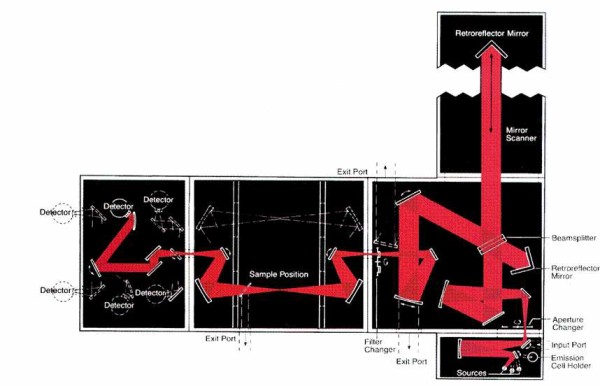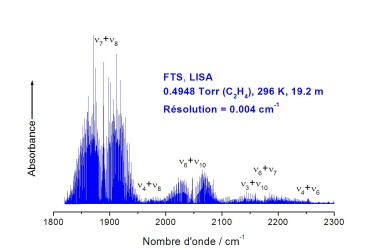Fourier Transform Spectrometer at high resolution Bruker IFS125HR
The high resolution spectrometer of LISA has a maximum nominal resolution of 0.0019 cm-1. The figure below shows the arrangement of the optical elements. Four different parts can be distinguished: the compartment source (lower-right), the heart of the interferometer (above sources) and the sample and detector compartments. All these compartments are put under vacuum to limit the absorption of certain atmospheric molecules, mainly water vapor (H2O) and carbon dioxide (CO2). The instrument has three different internal sources: mercury lamp (Hg) at high pressure, the Globar which is a silicon carbide rod (SiC) and tungsten lamp (W). External light may also enter the device via the port of entry (input port). Various separators, in Mylar (6 to 50 µm thickness), KBr, CaF2, and quartz, are available. At the exit of the interferometer, the light is focused through an optical filter and through secondary iris. The beam then passes into the sample compartment, which can contain up to two simple passage cells or transfer optics, which sends the beam in a cell to multiple reflections (of type White). We have two multiple reflection cells: 20 cm of base allowing optical passages between 0.80 m and 7.2 m and 80 cm of base allowing optical passages between 3.2 m and 40 m. Finally, the beam reaches the detector’s compartment. The following table lists typical combinations on the studied spectral range (approximate limits). Very recently, this instrument has enabled us to save the spectra of several molecules observed in planetary atmospheres: C3H8, C2H4, SCO - O2, SCO - N2, 15ND2H, 15NDH2, C2H4NH, CH3ONO, CD3ONO, H218O, etc.
|
Spectral range (cm-1) |
Source |
Séparator |
Detector |
|
20 - 400 |
Hg |
Mylar |
Si Bolometer |
|
500 - 4000 |
Globar |
KBr |
MCT (< 2000 cm-1), InSb (> 2000 cm-1) |
|
4000 - 10000 |
W |
FCa2 |
InSb |
|
10000 - 18000 |
W |
Quartz |
Si Photodiode |
 |  |
| Optical device of the Bruker IFS - 125 HR spectrometer | Example of spectrum recorded by TF at LISA |
The operation of a Fourier transformed spectrometer (Bruker IFS125HR) is based on the principle of Michelson’s interferometer. Such interferometer is composed of a separator (50% reflective) which divides an incident collimated beam into two parts. These two beams are reflected by two reflective mirrors (one fixed and the other mobile) and return on the separator. The two beams then travel different distances, where one is varied, which gives the difference of destructive and constructive optical interference.

